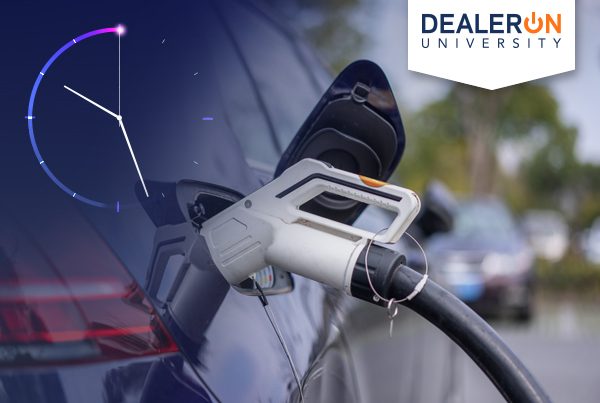

The ranges and charge times on EVs are shorthand for how good they are. But what do they mean and how to some of the most popular models stack up?

EVs—that’s electric vehicles—are on a sales tear over the first quarter of the year. With technology continuing to advance and demand pushing a greater abundance of charge points out in the world, there’s no reason to think this trend is likely to sour. The EV is a steadily improving market with tons of potential for a forward thinking dealer.
When selling EVs, the two factors that buyers want to know are charge time and range. The short answer is ultimately an unsatisfying one, which is that they depend on several factors. Charge time varies according not only to the battery in the vehicle itself, but the stats of the charging point. An EV’s distance—how far it can travel on a single charge—varies according to road and weather conditions. There is, however, a difference in quality that is ultimately measurable, allowing the discerning customer to comparison shop for a vehicle that meets their needs.
Charging point output is measured in kW (that’s kilowatts in case it’s been a minute since high school science) and range from a sluggish 3.7kW to a blistering 150kW. These numbers will likely increase as technology improves. For reference, home charging points tend to be 3.7kW or 7kW, with 22kW as an expensive option. Your typical EV takes a shade under 8 hours to fully charge off a 7kW charging point. The basic rule of thumb is this: the larger the battery and slower the charge point, the longer it takes an EV to charge.
Ready to save time and money by automating your monthly offers?
Schedule your free demo today!
Dealers should be aware of the opportunity to provide home charging solutions, and be prepared to talk about the time needed to charge the customer’s vehicle on one. Charging points can become an excellent supplemental source of revenue, as can other additional accessory options unique to EVs.
No conversation about EVs is complete without a discussion of the Nissan Leaf, the Chevrolet Bolt, and Hyundai’s various well-received offerings into the marketplace. To the list, I want to add the Ford F-150 Lightning, as the perennial best seller gaining an EV option is a watershed moment for the technology. Ford’s Mustang Mach-E also deserves some recognition.
The Leaf is the old timer on the marketplace with this year marking a full decade since it debuted. The Leaf’s range is a comparatively small 149 miles for the 40kWh battery and 259 for the kWh version. It bears mentioning that this is more than enough for a standard commute, and its price is exceedingly modest. To fully charge one of these overnight, a customer needs a 7kW charging point—3.7kW won’t get it done.
Dealers should be aware of the opportunity to provide home charging solutions, and be prepared to talk about the time needed to charge the customer’s vehicle on one.
Chevy’s Bolt has a range and charging time identical to the bigger version of the Leaf.
Appropriately, the price point is a bit higher as well. They offer Level 1 and Level 2 home charging points—customers will want the Level 2 to get an overnight charge.
Hyundai has both the Kona and Ioniq, both of which fare well on lists of the most desirable EVs on the market.
A big reason why is Hyundai’s standard 10 year warranty. While much automotive technology has improved enough to render such a warranty unnecessary, EVs can still benefit. The batteries are so expensive that a replacement battery can be more than the worth of the car, so if they give out (which can happen with infrequent driving), a backstop is a lifesaver.
The Kona Electric boasts a 258 mile range to the Ioniq’s 170.
Both are perfectly fine for a standard commute, but a customer might prefer a crossover (that’s the Kona) to a hatchback (that’s the Ioniq)—though the Ioniq has more cargo space, go figure. Both are around the same price point as the Bolt and Leaf, making them excellent options, and both will need the same kind of home charging point for optimal convenience.
Ford’s Mach-E has one of the most elusive qualities in the larger EV marketplace: it’s cool.
Along with its sister model, the even zippier Mach-E GT, its a crossover with a sporty pedigree that doesn’t have to go to the pump. Its range is a solid 230 miles. Its 68kWh battery means customers will want a 7kW charger at home minimum.
The Ford F-150 Lightning is a remarkable vehicle for any number of reasons, not the least of what it says that Ford is taking the biggest name in the industry electric.
Even beyond driving, the F-150’s power plant can actually power a home for “up to three days on a fully charged battery.” Useful if disaster strikes. Its range is comparable to the Mach-E, or you can bump it up to a 300 mile range, which comes free with an 80-amp charger. That will get you a full charge overnight, if you’re wondering.
Customers should keep in mind that in order to get the convenience that an EV can offer, they will need to have a home charging point, and one that can handle the challenges of their specific vehicle. For any day commuter, this means a 7kW version, and allowing a vehicle to charge overnight. With that in mind, any of these can be an excellent choice.
More Articles From DealerOn University
-
- For customer experience, your website is only the beginning. These six tips will help improve your customer experience.
- Everything you need to know about the Google FLoC privacy update.
- Looking at EVs on the horizon.


